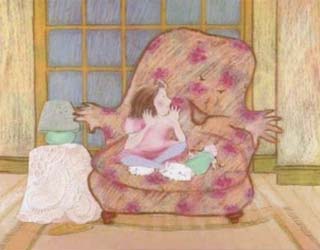Description
This clip shows an animated story for young children about the day Bernadette's grandmother dies. The house is full of people but everyone seems too busy to talk to Bernadette. She sits in Grandma's armchair, which comes to life and comforts her. The chair is concerned that it is no longer of use now that Grandma is dead but Bernadette suggests that it can now be a chair shared by her and Grandpa. The animation is based on a simple storybook style using a narrator and pastel drawings to bring the story to life. It includes music.
Educational value
- This clip illustrates how sensitive and imaginative animated stories offer children a way to explore emotions, family issues and fears associated with the death of a loved one. In animation, the gap between real life and fiction is greater than in drama, allowing children to use their imagination and empathy while remaining safe emotionally.
- The animation illustrates how children may respond to the death of a family member by feeling afraid and alone. Bernadette wants to stay in bed when she hears crying downstairs and then wants to escape to school rather than cope with the reality of the death of her grandmother. Her feeling of loneliness is also due to her inexperience of the situation resulting in her not knowing what to say to her mother or grandfather.
- The story emphasises that children may react differently from adults when a loved person dies, perhaps becoming difficult (such as when Bernadette refuses the help of a neighbour), but they can also use their imagination to resolve or come to terms with a difficult situation. Bernadette imagines that the chair is talking to her about how much they will both miss Grandma. This provides comfort and support.
- The animation illustrates how young children may not know how to comfort others who are suffering grief. Initially, Bernadette feels that she does not know what to say to her grandfather, but she finds a way to share his grief through her imaginary quest to help the chair find a new occupant.
- The animation includes elements of orientation, complication and resolution that are comforting and reassuring to children. For example, the slow opening scene of the story shows Bernadette in bed in wide shot. There is a lot of detail in the illustration and time is taken for the audience to explore the room and finally the person in it while the narration, from Bernadette's point of view, introduces the impending issue.
- The clip illustrates how a sense of animation can be achieved with the camera alone. There is very little attempt at animation within the illustrations in this clip. Rather, the camera creates a sense of movement by slowly panning across each drawing and zooming in and out to create movement and focus on particular elements in the illustrations. This provides time for the audience to focus on the characters, narration and the emotional theme of the story.
- This short animated film is one of the resources produced as part of the 'Lift Off' educational television series produced by the Australian Children's Television Foundation. 'Lift Off' is an early childhood program, designed to entertain while it educates, targeting children between the ages of 3 and 8. The series won an Australian Film Institute Award for Best Children's Television Drama as well as a United Nations Association of Australia Media Peace Award and an Australian Teachers of Media (ATOM) Award.
- According to its website, the Australian Children's Television Foundation provides further information about animation and how to make different forms of animation in its Animation Teaching Kit, intended for teachers and an audience of children aged 8 and upwards.

